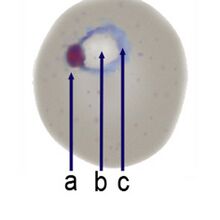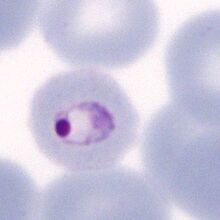|
|
| (35 intermediate revisions by 2 users not shown) |
| Line 1: |
Line 1: |
| | ---- |
| | '''Navigation'''</br> |
| | [[Plasmodium falciparum: Morphology|Go Back]] |
| | ---- |
|
| |
|
| ---- | | {| class="wikitable" style="border-style: solid; border-width: 4px; color:black" |
| | |colspan="1" style = "font-size:100%; color:black; background: FFFAFA"|<span style="color:navy>'''What is a ring form?'''</span> |
|
| |
|
| '''What is a ring form?'''
| |
|
| |
|
| <gallery mode="nolines" widths="220px" heights="220px" > | | <gallery mode="nolines" widths="220px" heights="220px" > |
| File:Ring_c.jpg|link={{filepath:|Ring_c.jpg}} | | File:Ring_c.jpg|link={{filepath:|Ring_c.jpg}} |
| | File:MMETr.jpg|link={{filepath:|MMETr.jpg}} |
| </gallery> | | </gallery> |
|
| |
|
| Line 17: |
Line 22: |
|
| |
|
|
| |
|
| At the earliest stage of red cell infection parasites of all species have the form of a "ring". Distinction between species at this stage may not be easy (or even possible). However as the parasite mature and develop differences between species become more apparent. In some species the ring appearance is maintained until late stages of maturation, in others there is loss of a typical ring appearance | | At the earliest stage of red cell infection parasites of all species have the form of a "ring". Distinction between species at this stage may not be easy (or even possible). However as the parasites mature and develop differences between species become more apparent. In some species the ring appearance is maintained until late stages of maturation, in others it is lost progressively as they mature. |
| | |
| *''P.falciparum'': Typically the rings small and delicate, rings tend to persist from early trophozoite until late stages although they may thicken
| |
| *''P.ovale'': Typical rings are large and robust and this shape may persist until late stages of development (contrast with ''P.vivax'')
| |
| *''P.malariae'': Rings are small but more substantial that ''P.falciparum'' becomeing solid or bad and losing the ring appearance as they develop
| |
| *''P.knowlesi'': Early forms resemble ''P.falciparum''; as they mature they often extend and become solid or band-like resembling ''P.malariae
| |
| *''P.vivax'': Early stages appear as rings becoming irregular then eventually taking on a more typical amoeboid appearance at later stages
| |
| | |
| | |
| | |
| These changes can be very useful in identifying the different malaria species; these are illustrated for maturing trophozoites below:
| |
| | |
| ----
| |
| ''' ''P.falciparum'' '''
| |
| | |
| | |
| <gallery mode="nolines" widths="220px" heights="220px" >
| |
| File:MFETr.jpg|link={{filepath:MFETr.jpg}}
| |
| File:MFITr.jpg|link={{filepath:MFITr.jpg}}
| |
| File:MFLTr.jpg|link={{filepath:MFLTr.jpg}}
| |
| </gallery>
| |
| | |
| ''Small and often delicate rings that thicken at later developmental stages although they remain relatively small with a "ring appearance". Noe also the appearance of characteristic Maurer's dots and clefts within the red cell cytoplasm as the parasites develop.''
| |
| | |
| ----
| |
| ''' ''P.ovale'' '''
| |
| | |
| <gallery mode="nolines" widths="220px" heights="220px" >
| |
| File:MOETr.jpg|link={{filepath:|MOETr.jpg}}
| |
| File:MOITr.jpg|link={{filepath:MOITr.jpg}}
| |
| File:MOLTr.jpg|link={{filepath:MOLTr.jpg}}
| |
| </gallery>
| |
| | |
| ''The rings are larger and more robust than in ''P.falciparun'', and they enlarge further during parasite development although in this species the characteristic ring appearance can often still be distinguished even late in development.''
| |
| | |
| ----
| |
| ''' ''P.malariae'' '''
| |
| | |
| | |
| <gallery mode="nolines" widths="220px" heights="220px" >
| |
| File:MMETr.jpg|link={{filepath:|MMETr.jpg}}
| |
| File:MMITr.jpg|link={{filepath:MMITr.jpg}}
| |
| File:MMLTr.jpg|link={{filepath:MMLTr.jpg}}
| |
| </gallery>
| |
| | |
| ''The rings are small but generally appear more robust than ''P.falciparum'', the parasites become more solid often losing the central digestive vacuole and may become angular or extend as a band across the cells.''
| |
| ----
| |
| ''P.knowlesi''
| |
| | |
| | |
| <gallery mode="nolines" widths="220px" heights="220px" >
| |
| File:MKETr.jpg|small or normal ''P.malariae (round)|link={{filepath:|MKETr.jpg}}
| |
| File:MKITr.jpg|normal sized ''P.falciparum'' (round)|link={{filepath:MKITr.jpg}}
| |
| File:MKLTr.jpg|ormal or enlarged ''P.ovale'' (may become ovoid)|link={{filepath:MKLTr.jpg}}
| |
| </gallery>
| |
| | |
| | |
| ----
| |
| ''P.vivax''
| |
| | |
|
| |
|
| <gallery mode="nolines" widths="220px" heights="220px" >
| | The different appearances of rings (or indeed their loss) can be very useful in identifying the different malaria species. For detailed illustration of maturing trophozoites [[Trophozoites: diagnostic guide|see this link]]: |
| File:MVETr.jpg|small or normal ''P.malariae (round)|link={{filepath:|MVETr.jpg}}
| |
| File:MVITr.jpg|normal sized ''P.falciparum'' (round)|link={{filepath:MVITr.jpg}}
| |
| File:MVLTr.jpg|ormal or enlarged ''P.ovale'' (may become ovoid)|link={{filepath:MVLTr.jpg}}
| |
| </gallery>
| |
| | |
| | |
| | |
| ----
| |

